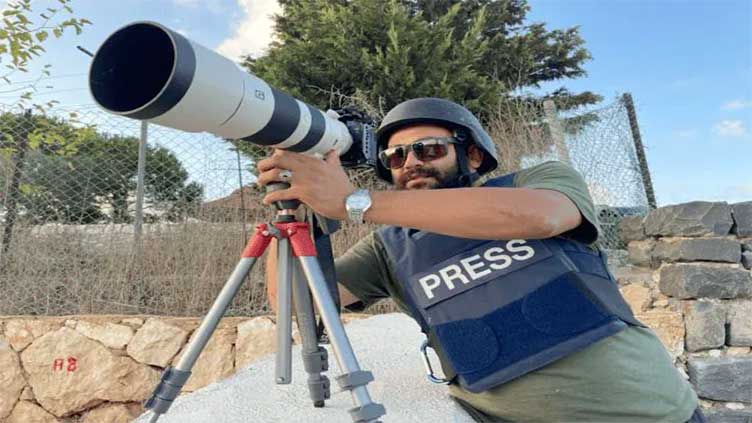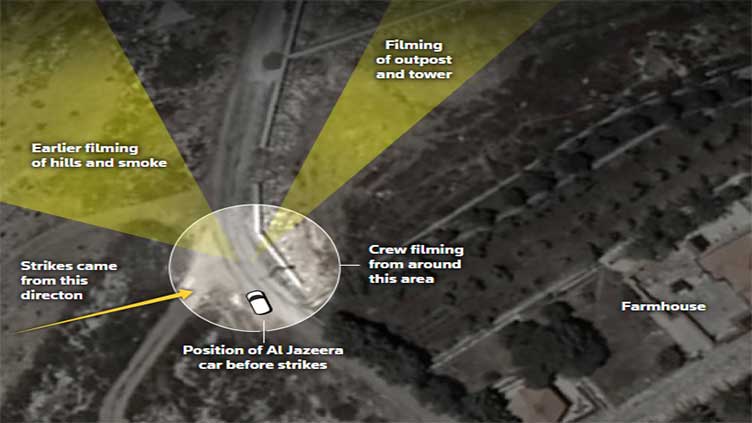Israeli tank fire killed Reuters journalist Issam Abdallah in Lebanon

World
Two strikes killed Reuters visuals journalist Issam, 37, and severely wounded AFP photographer Assi
An Israeli tank crew killed a Reuters journalist and wounded six reporters in Lebanon on Oct. 13 by firing two shells in quick succession from Israel while the journalists were filming cross-border shelling, a Reuters investigation has found.
The two strikes killed Reuters visuals journalist Issam Abdallah, 37, and severely wounded Agence France-Presse (AFP) photographer Christina Assi, 28, just over a kilometre from the Israeli border near the Lebanese village of Alma al-Chaab.
Reuters spoke to more than 30 government and security officials, military experts, forensic investigators, lawyers, medics and witnesses to piece together a detailed account of the incident. The news agency reviewed hours of video footage from eight media outlets in the area at the time and hundreds of photos from before and after the attack, including high-resolution satellite images.
As part of its investigation, Reuters also gathered and obtained evidence from the scene including shrapnel on the ground and embedded in a Reuters car, three flak jackets, a camera, tripod and a large piece of metal.
The Netherlands Organisation for Applied Scientific Research (TNO), an independent research institute that tests and analyses munitions and weapons for clients such as the Dutch defence ministry, examined the material for Reuters at its laboratories in The Hague.
TNO’s key findings were that the large piece of metal was the tail fin of a 120 mm tank round fired by a smoothbore tank gun positioned 1.34 km away from the reporters, across the Lebanese border.
Reuters presented the Israel Defense Forces (IDF) with its findings that the tank rounds were fired from within Israel and posed additional detailed questions, including whether Israeli troops knew they were firing upon journalists.
Lieutenant Colonel Richard Hecht, the IDF’s international spokesman, said: “We don’t target journalists.” He did not provide further comment.
The group of seven reporters from AFP, Al Jazeera and Reuters were all wearing blue flak jackets and helmets, most with “PRESS” written on them in white letters. There were journalists from at least another seven media outlets in and around Alma al-Chaab that day.
“The evidence we now have, and have published today, shows that an Israeli tank crew killed our colleague Issam Abdallah,” Reuters Editor-in-Chief Alessandra Galloni said.
“We condemn Issam’s killing. We call on Israel to explain how this could have happened and to hold to account those responsible for his death and the wounding of Christina Assi of the AFP, our colleagues Thaier Al-Sudani and Maher Nazeh, and the three other journalists,” she said. “Issam was a brilliant and passionate journalist, who was much loved at Reuters.”
‘Inexplicable and unacceptable’
AFP said the evidence assembled by Reuters confirmed its own analysis of the incident.
“It is absolutely essential that Israel provides a clear explanation for what happened. The targeting of a group of journalists who were clearly identified as media is both inexplicable and unacceptable,” said AFP Global News Director Phil Chetwynd.
Al Jazeera's manager of international communications, Ihtisham Hibatullah, said: "The Reuters investigation into the October 13 attack underscores Israel's alarming pattern of deliberately targeting journalists in an attempt to silence the messenger.”
International humanitarian law bars attacks on journalists as those in the news media have the full scope of protection granted to civilians and cannot be considered military targets.
In the days after the attack, Israel’s military said it was reviewing what had happened, but it has not made any findings public.
International criminal law expert Carolyn Edgerton, who has worked on war crimes cases in the Balkans, said filming Israeli tank positions at the border might have been considered a threat to the Israeli military, if that information was seen to “be of targeting value to forces in Lebanon”.
But she said in written responses to Reuters questions that two back-to-back rounds fired at a group of clearly identified journalists “is a clear violation of international humanitarian law and may also amount to the war crime of attacking civilians”.
Directly targeting civilians or civilian objects is strictly forbidden under the laws of armed conflict, such as the 1949 Geneva Conventions, which have been ratified by all U.N. member states. Neither Israel nor Lebanon are signatories to the International Criminal Court, whose 124 member states accept its jurisdiction in the prosecution of war crimes, crimes against humanity and genocide.
Shells hit 37 seconds apart
The attack was the first of two deadly strikes in the space of six weeks on reporters in Lebanon covering clashes between the Israeli military and Iranian-backed Hezbollah militants along the border in the wake of the Oct. 7 attack on Israel by Hamas.

Two journalists from Lebanese broadcaster Al Mayadeen were killed by a strike on Nov. 21 as they filmed near the border with Israel. Al Mayadeen blamed the IDF for their deaths. The Israeli military said in a statement it was a dangerous area to be in because of “active hostilities”.
Since the Gaza war started, Israeli forces and Hezbollah have traded fire on an almost daily basis across the border - known as the UN Blue Line, because it was demarcated to mark the point to where Israeli forces withdrew from southern Lebanon in 2000.
On Oct. 13, reports of armed fighters attempting to infiltrate into Israel from Lebanon and subsequent cross-border shelling drew reporters from at least 10 Lebanese and foreign news organisations - including Italian broadcaster Rai, German daily Die Welt and the Associated Press - to the area in and around Alma al-Chaab.

A Reuters team of three drove with two colleagues from AFP to a spot to the east of the village where Al Jazeera had been broadcasting a live feed of the border earlier that day.
Once set up, Reuters started feeding live footage to its TV clients around the world at 5.16 p.m. (1516 GMT), the sound of occasional shelling punctuating the steady shot of smoke rising from behind a wooded ridge to the south.
After filming for 45 minutes, amid the incessant buzz of drones overhead and an Israeli helicopter patrolling high in the sky, the Reuters team turned the camera to focus on an Israeli military outpost just over two kilometres away at Hanita and filmed a tank firing a shell from there into southern Lebanon.
The AFP and Al Jazeera teams were also broadcasting live and moved their cameras at the same time to show the Israeli outpost at Hanita as well.
Less than 90 seconds later, the first of two tank rounds fired from a different outpost smashed into Abdallah and the low wall he was leaning on, killing him instantly and knocking out the Reuters live feed.
The tripods holding the AFP and Al Jazeera cameras were a few metres further away and carried on broadcasting, capturing clouds of dust rising behind them and the cries of AFP’s Assi who had been hit in the legs by shrapnel.
Thirty seven seconds later, a second shell smashed into Al Jazeera’s car, setting it ablaze, knocked out the AFP feed and toppled Al Jazeera’s camera - leaving it filming clouds high in the sky above and capturing the curses and screams of the wounded journalists.



